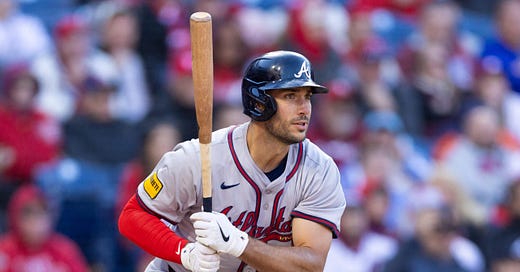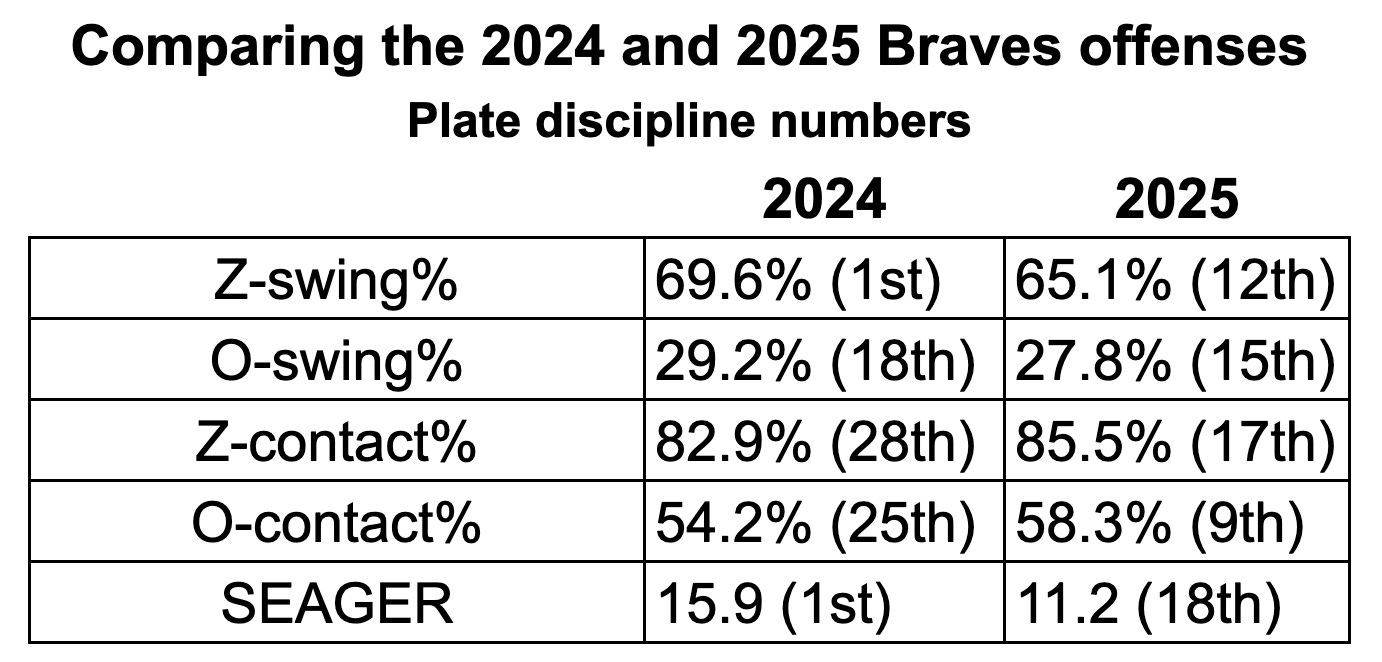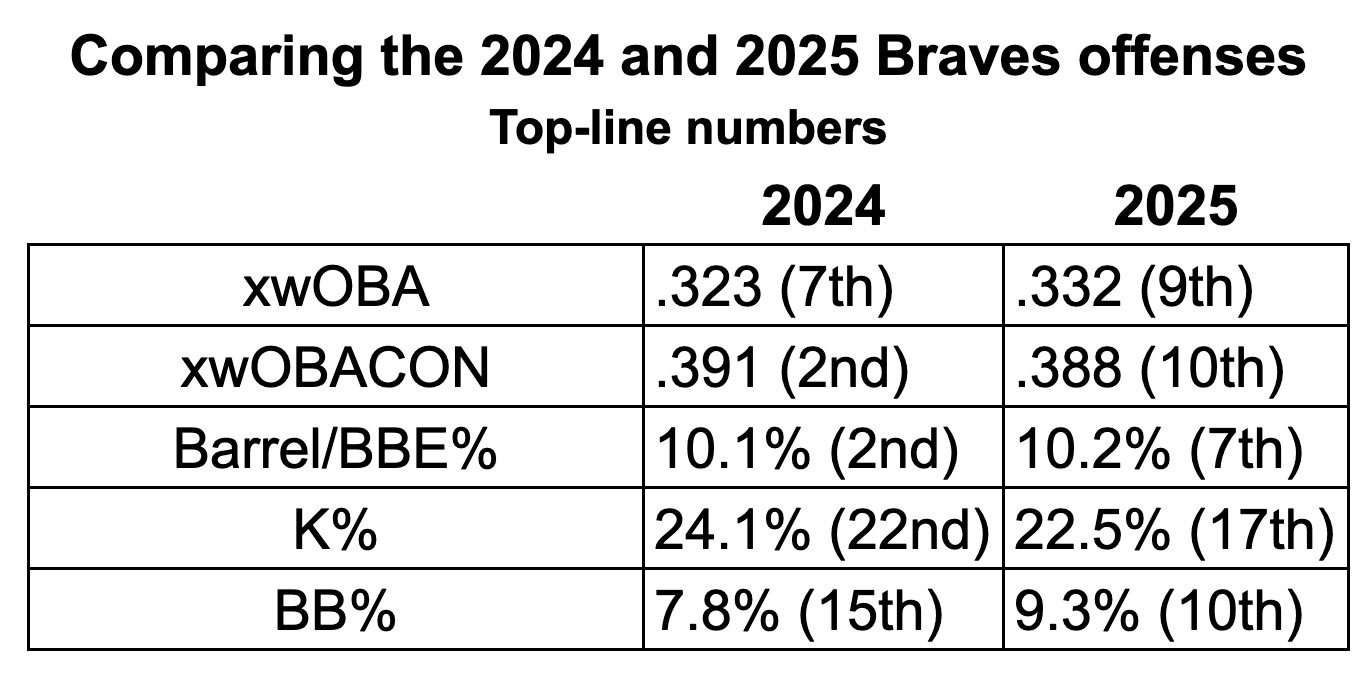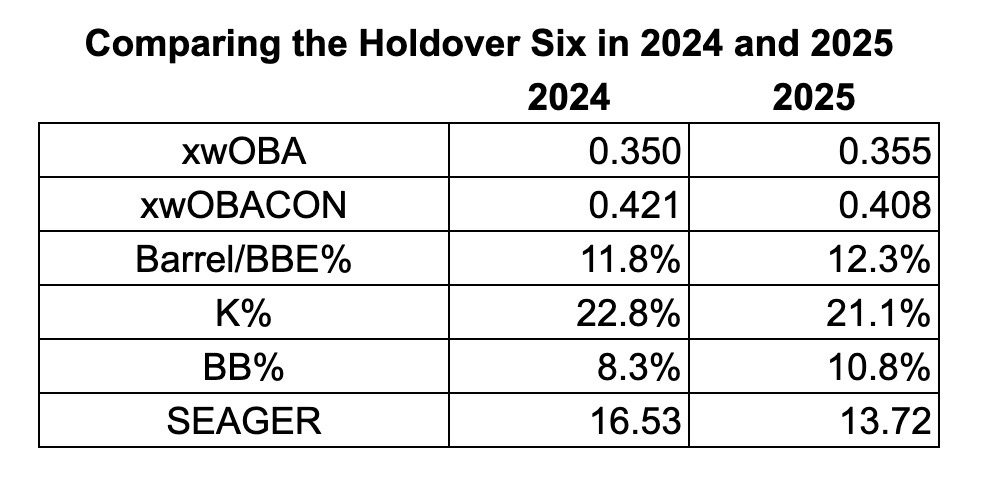What is Tim Hyers up to?
A month in, the Braves' new offensive approach is difficult to pin down. I'm giving it a try anyway.
I liked former Braves hitting coach Kevin Seitzer a lot. Based on what we knew publicly, his firing baffled me; the Braves were just a year removed from having maybe the most prolific offense in franchise history and maintained good offensive peripherals despite being snakebitten with injuries and horrible batted-ball luck in 2024. The philosophy that Seitzer preached - find strikes, swing hard, and elevate the ball - came to be seen as the paragon of modern offense.
So I was curious what replacing Seitzer with Tim Hyers signaled about the offensive direction of the team. As Ivan the Great over at Battery Power described it, Hyers coached some very Seitzer-y Red Sox teams and then spent three confusing seasons with the Rangers. In his introductory press conference with Atlanta media, Hyers described his plan as not only reducing the Braves’ chase rate but also coaching hitters to be more selective at the pitches they attacked within the strike zone. So I somewhat optimistically suggested the following:
Hyers’ initial comments suggested some interest in ensuring that hitters aren’t just swinging at strikes, but are swinging at strikes that fit within their hot zones. So maybe we’ll see a slight decreases in Z-swing% and O-swing% next year. The Rangers were still plenty aggressive in the zone - just not to Atlanta’s level. If Hyers thinks that he can coach Braves hitters to pick their spots more intelligently, the improvement in quality of contact (which is already very good) may be worth watching some strikes go by. And it might even come with a slight drop in chase rate.
So has that happened so far?
Yep. It’s been more dramatic that I would’ve envisioned, though. The Braves are always at the top of the league at swinging at strikes and always at the bottom of the league in making contact with those pitches. The second part sounds like an unambiguously bad thing, I know, but whiffing a ton is inherent in swinging big and in anything but a two-strike count, a swing and a miss (and thus another chance at a swing) is probably a better outcome than, say, a weak dribbler or mishit popup. The 2025 Braves are swinging at fewer strikes and fewer balls and making more contact. SEAGER is a Baseball Prospectus metric that blends this all together nicely - it rewards hitters for laying off bad pitches but penalizes them for not swinging aggressively at pitches they can hit hard. In this metric, the Braves have gone from elite to nondescript.
So how has that affected their offensive performance?
Not so much so far! The Braves have seen their xwOBA improve slightly from 2024, but the league as a whole has put up better xwOBAs this year (.326 in 2025, .312 in 2024). So as you can see in the rankings, the Braves have taken steps back in xwOBA, xwOBACON (that’s xwOBA but only on balls in play), and barrel rate, even though they’ve nominally improved or stayed virtually the same in those metrics. There are real improvements to the team’s strikeout and walk rates, though, and that’s helped blunt the sting of the team’s contact quality going from elite to merely good.1
One of the issues with this comparison is that the 2024 Braves and 2025 Braves didn’t have identical rosters. The 2024 Braves got plate appearances from Jorge Soler and Ramon Laureano, the former of whom is a SEAGER darling,2 whereas the 2025 Braves have filled those plate appearances with Bryan de la Cruz and Alex Verdugo, both of whom SEAGER really dislikes. So I decided to compare the ‘Holdover Six’ - the six everyday hitters from the 2024 Braves who are getting everyday PAs in 2025. That’s Marcell Ozuna, Matt Olson, Austin Riley, Sean Murphy, Ozzie Albies, and Michael Harris II.
We see similar effects here. Slight nominal increase in xwOBA, slight drop in xwOBACON, meaningful changes in strikeout and walk rates, and a reduced SEAGER score. So the year-over-year differences aren’t just explicable by a change in the supporting cast.
It gets more interesting if you drill down a bit further, though. Austin Riley’s SEAGER score has gone from ‘elite’ to ‘good’, but it’s not because he’s gotten too passive - he’s actually swinging at strikes at a higher rate than before. Marcell Ozuna and Matt Olson have always been beloved by SEAGER and that hasn’t changed. After a down year for his swing decisions, Sean Murphy is back in SEAGER’s good (if not great) graces. Albies is really struggling to do damage on balls in play but is basically the same gross-but-playable guy in SEAGER’s eyes that he was last year. Really, the drop in SEAGER among this group is completely accounted for by Michael Harris II going from ‘bad’ to ‘horrific’ in the metric’s eyes. It’s not clear what Harris is trying to do - he’s been swinging at strikes at a very low rate and swinging at balls at a very high rate while seemingly trying to shorten up his swing and slap the ball - but he’s at least seen his xwOBA rise over the last couple of weeks (.367 in his last 50 plate appearances) so hopefully he’s not going to do whatever that is much longer. The Holdover Six would be sixth in baseball in SEAGER if they were their own team; remove Harris and they’d be first.
So the takeaway in my eyes: Tim Hyers certainly isn’t just taking the Kevin Seitzer playbook and running with it. The Hyers Braves offense will swing less - at strikes, at balls, at everything. You’ll probably see fewer annoying first-pitch grounders and pop-outs, but you’ll also probably fewer moonshots on get-me-over first pitches. But interestingly, the best hitters on the team are in large part the same guys they always were.
Now if someone will just get Michael Harris II on that plan . . .
We’re still early enough in the season that these numbers are volatile. The 2025 Braves were 5th in xwOBACON headed into this week’s series against the Rockies and then . . . simply didn’t hit the ball particularly hard for three days.
To say nothing of Ronald Acuña Jr., who will hopefully be back in the mix soon.









Great analysis on the team. I’m interested in how the SEAGER metric compares with other playoff contending teams? As much as the big 6 hitters performed on metric last year, the offense was (or felt) pretty bad last year. I don’t think a change of approach is necessarily bad if the Braves were such a predictable team to pitch against after 2023?